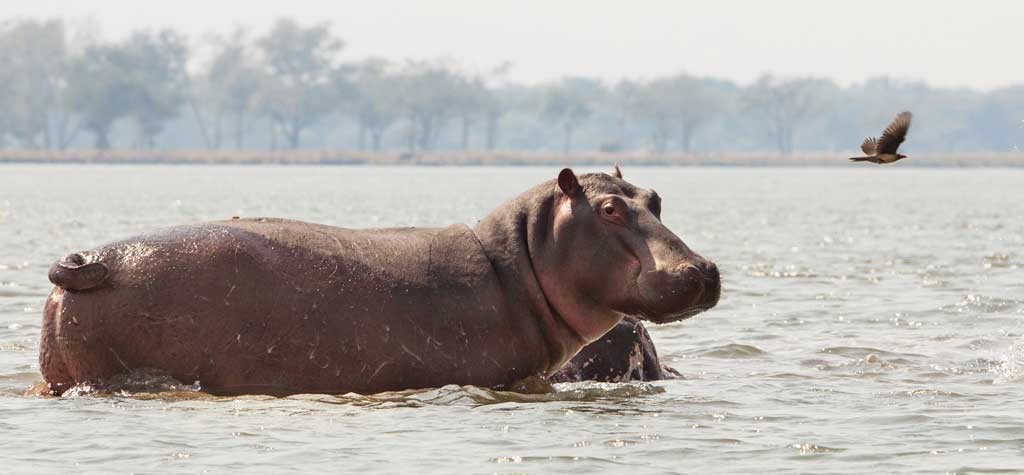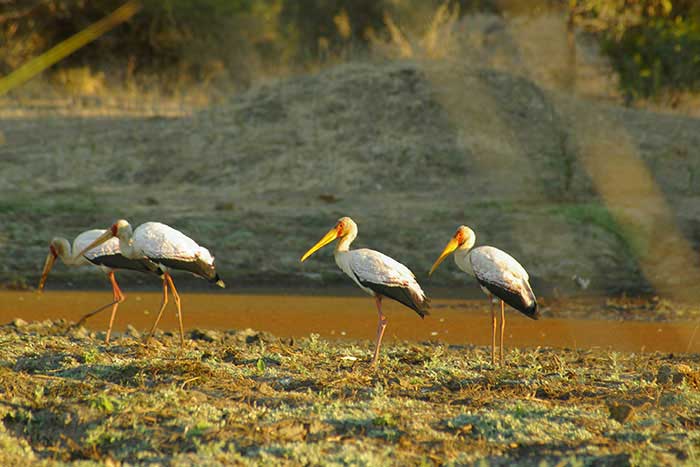Mana Pools Canoe Fact File
Physical Features of The Lower Zambezi River
The Zambezi River is the 4th largest in Africa, after the Nile, Congo and Niger. The River’s source is at Kalene Hills in North Western Zambia and flows approximately 2800 kilometers to Chinde in Mozambique, where it flows into the Indian Ocean.
Below Kariba Dam the narrowest point is approximately 80 meters and the widest point is 4.2 kilometers near Chikwenya, an island inside Mana Pools National Park.
From the first put-in point, a short distance below Kariba Dam Wall, the Kariba Gorge is narrow and fairly steep sided, this continues for 18 kilometers before the River opens out into a wide flood plain. The flood plain continues until the Chewore River mouth where the River narrows again at the start of the Mupata Gorge, which is approximately 46 kilometers long. This section is not as steep as Kariba Gorge, but is beautiful and very remote
The River has not flooded since the wall was built as the dam regulates the flow. (There was a minor flood when three dam wall gates were opened in the year 2000. However, this had minimal effect to the ecology downstream.) There are not enough tributaries below the wall to cause a flood during the heavy rains.
There are no rapids on this section of the river. The water is flat all the way from Kariba to Kanyemba, with an average flow rate of 4 km per hour.
The depth of the River varies from 24 -30 meters in the gorges to as little as 150 centimeters in the flood plain areas, although there is always a deep-water channel. There are a lot of islands and sandbanks, which make good camping spots.

Mana Pools National Park
Mana Pools National Park is situated along 80km of the Zambezi River, making for the best game viewing on the lower Zambezi. Here one can participate in canoeing, walking and/or game drives – or simply relax and take in the breathtaking beauty. Mana Pools is consistently rated in the top ten of Africa’s National Parks.
Mana Pools is the only game park in Zimbabwe to be granted World Heritage Status and encompasses some of Africa’s largest areas of Acacia and Mahogany woodland, combined with spectacular, full-canopy Mopane forest. Mana Pools is part of a 300 million year old rift valley supporting a large variety of mammals and over 400 bird species.
Covering over 200 square kilometers, this national park has been set aside to be kept as wild as possible. There is only non-invasive, zero-impact tourism allowed. There are no safari lodges, generators, electric fences or other structures associated with safari camps as these are banned by law.
All our camps must be taken down the day after our clients depart to ensure minimal damage to the ecosystem.

Wildlife is abundant in the valley especially during the winter months from June through to late August with game still being clearly visible through to the end of October / early November when the rains start.
The River runs through the Hurungwe Safari Area, Mana Pools National Park, Sapi Safari, Chewore Safari and Dande Safari areas respectively. Wildlife will be seen on every trip, most commonly impala, waterbuck, hippo, crocodiles, elephant and buffalo. Animals such as lion, leopard, etc, are more difficult to see but are certainly present. Wildlife is much more abundant in Mana Pools, especially during the height of the dry season (July to October) when the game viewing can be fantastic.
During the rainy season (mid November to end of March) the game is around but not as easily visible due to lush, thick vegetation and also the fact that there is more inland water (water holes) around for the animals therefore they do not need to congregate at the river to drink
The semi-participatory Explorer canoe safari options begin and end in Kariba (unless by other arrangement) and we recommend clients spend the night prior to trip departure, in Kariba town. We can assist with booking accommodation. Trips depart from our offices at approximately 08h30 and clients are collected if necessary and taken to our Kariba Offices to organize for luggage and personal items to be locked away and kept until their return and then on to the shops to purchase any extras they might require, as well as drinks of their choice. These trips are expeditionary-styled. All equipment is carried on the canoes and the canoeist’s camp on islands each evening.
Included in the cost of the semi-participatory safaris are return Kariba transfers to / from the safari; all camping and canoeing equipment; all meals; teas, coffees, cordials and wine with dinner and services of a fully qualified canoe guide. National Parks Fees and other drinks are not included in any costs. Please check with your booking agent before travel. On the last day of the safari, a vehicle meets the party and clients and equipment is transferred back to Kariba.
We cannot guarantee that clients will arrive back in time to catch flights the same day. Clients wishing to catch connecting flights must advise the guide and either have all luggages with them or organize the driver to bring down any extra luggage when he picks the clients up. The airport is on the way back to Kariba and there may not be enough time to return to hotels and then go back to the airport
Daily Routine
Generally the day starts with tea / coffee and biscuits at sunrise. The camp is packed and the party sets off. These early mornings make for easy paddling as the wind is calm and it is not too hot. A stop will be made for breakfast, usually after a couple of hours. Stops are made at any point of interest. The trip continues after breakfast, until breaking for a light lunch and siesta between noon and two pm. The night stop is reached at approximately
5pm. Camp is unpacked and set up and dinner prepared. Camp is generally set up on islands, at sites designated by National Parks. There are no ablution facilities. Clients are provided with toilet rolls, a spade and matches to burn the toilet paper. Bathing is done using water scooped out of the River in a bucket. Bio-degradable soap can be used in the River. Distance covered per day is approximately 22 kilometers.


